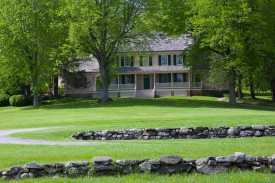John Jay was born in New York City in 1745. His grandfather, Augustus Jay, had been a French Huguenot who came to America in the 1680s seeking religious freedom. His father, Peter Jay, gained wealth as a merchant, and retired to a farm in Rye, New York, shortly after John was born. Following formal education at King’s College (today Columbia University), Jay began a career as a lawyer. However, as the talk of independence from Great Britain grew, Jay became increasingly involved in public service. He would never return to his law practice.
In 1774, Jay married Sarah Van Brugh Livingston (1756-1802), daughter of the fiery patriot and first governor of the State of New Jersey, William Livingston. Sarah Jay, renowned for her beauty, intelligence, and charm, was a devoted wife and the doting mother of the couple’s five children.
Of all the Founding Fathers, no other filled so many high offices. John Jay served the State of New York as a principal author of its first constitution in 1777, and as its first Chief Justice. He served the nation as President of the Second Continental Congress, Minister Plenipotentiary to Spain during the Revolutionary War, and Secretary for Foreign Affairs under the Articles of Confederation. He was author and key negotiator, with Benjamin Franklin and John Adams, of the Treaty of Paris, which ended the American Revolution. With Alexander Hamilton and James Madison, he wrote the Federalist Papers, arguing for adoption of the United States Constitution. After the ratification of the Constitution, President Washington appointed Jay the first Chief Justice of the United States.
In 1794, at Washington’s bidding, Jay went to England to negotiate a treaty both men knew would be controversial. Although unpopular in its day, the Jay Treaty resolved a number of differences with Great Britain left over from the Revolution, delayed open conflict until the War of 1812. It has been said this treaty cost Jay the chance to succeed Washington as president.
Upon his return to New York from England in 1795, he was elected the state’s second governor, and served two three-year terms. As Governor, he signed the “Act for the Gradual Abolition of Slavery.” In 1801, after twenty-seven years of arduous public service, he decided it was time to retire from public life.
By that year, Jay had acquired, by inheritance and purchase, 750 acres of land near present-day Katonah. During his second term as governor, Jay had renovations made to his farmhouse in Westchester in preparation for his retirement. He moved there in 1801. His beloved wife Sarah died the following spring, leaving him a widower with his three youngest children still at home. Jay never remarried. He lived in the house until his death in 1829, quietly enjoying his life as a country farmer, keenly interested in agriculture, his family, and his religion. An avid reader of the Bible, Jay served for seven years as President of the American Bible Society.




